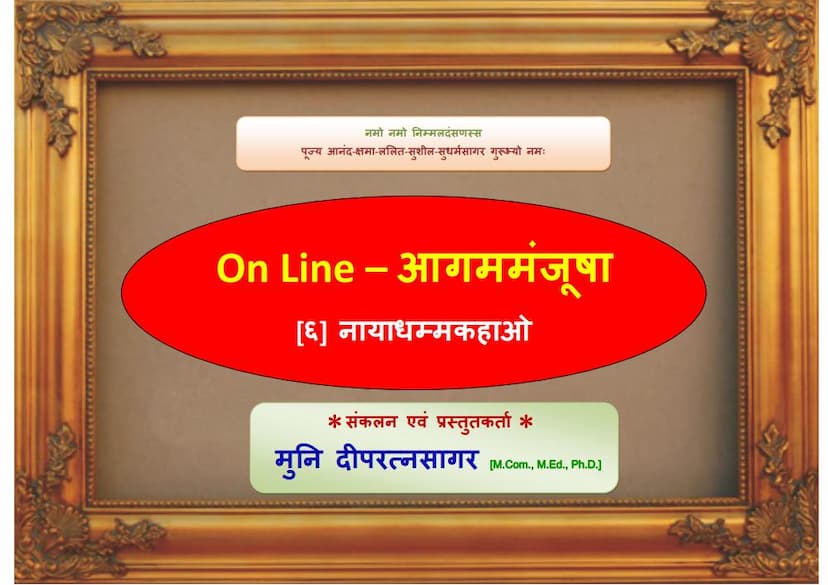Aagam Manjusha 06 Angsuttam Mool 06 Nayadhammkaha
Added to library: September 1, 2025

Summary
This document is a digitized version of the Jain text "Aagam Manjusha 06 Angsuttam Mool 06 Nayadhammkaha" (also known as Niyayadhammakahao), compiled and presented by Muni Deepratnasagar. The text itself is a collection of stories and teachings from the Jain Agamas, specifically from the Nayadhammakahao chapter of the Angas, which is the sixth Anga.
Key aspects covered in the provided pages:
-
Preamble and Context: The initial pages provide a brief introduction to the "Aagam Manjusha" series, noting that the original edition was compiled 70 years prior (around 1942 CE / V.S. 1998 / V.S. 2468) by Acharya Shri Anand sagarsuriji. The digital online version, "OnLine-Aagam Manjusha," was released in 2012 CE / V.S. 2068 / V.S. 2538. It also highlights some editorial variations and inclusions from the original edition, such as the inclusion of Niyukti and Bhashya along with original sutras in certain texts.
-
Content of Nayadhammakahao:
- The text begins with the invocation "Om Namah Sarvajnyaaya" and the start of the story in the city of Champa, under King Konika.
- It introduces a disciple of Lord Mahavir, Acharya Ajatasvami (Ajayasvami), and his disciple Ajatajambu.
- The core of the text consists of dialogues and narratives explaining Jain principles, karma, rebirth, and the path to liberation.
- Detailed Narrative of Meha Kumara: A significant portion of the text is dedicated to the story of Meha Kumara. This narrative is rich in detail and includes:
- The divine dream of Queen Dharini, wife of King Shrenik, predicting the birth of a noble son.
- The interpretation of the dream by scholars, foretelling the son's greatness, valor, and potential spiritual inclination.
- Meha Kumara's upbringing, education in various arts and sciences, and his subsequent renunciation of worldly pleasures.
- His spiritual journey, severe austerities (tapas), and eventual attainment of Kevala Jnana (omniscience) and Nirvana (liberation).
- The story also illustrates the consequences of past actions (karma) through Meha Kumara's previous lives, highlighting the interconnectedness of deeds and their results. The narrative emphasizes detachment from worldly desires and the importance of following the Jain path of righteousness and non-violence.
- Stories of Dhan, Vijaya, and others: The text also includes several other illustrative stories that explain Jain ethical principles and the repercussions of good and bad actions. These stories often involve merchants, thieves, gods, and their interactions, demonstrating the principles of karma, dharma, and ethical conduct.
- Emphasis on Jain Practices: The text implicitly or explicitly refers to Jain practices such as:
- The importance of faith and right conduct (Samyak Darshan, Charitra).
- The concept of rebirth and transmigration of the soul.
- The rigorous path of asceticism and penance.
- The ultimate goal of liberation from the cycle of birth and death.
-
Structure of the Text: The Nayadhammakahao appears to be structured into various chapters or "adhyayana" (lessons or sections), each potentially focusing on a specific teaching or narrative. The provided text seems to cover the first 18 chapters, with indications for the start of further chapters.
Overall Significance:
The "Nayadhammakahao" is a foundational text in Jainism, providing profound insights into the Jain worldview, ethics, and the path to spiritual enlightenment. The stories serve as moral exemplars and cautionary tales, illustrating the principles of karma, righteousness, and the importance of right conduct for achieving ultimate liberation. The digitized version makes this ancient wisdom accessible for study and contemplation.